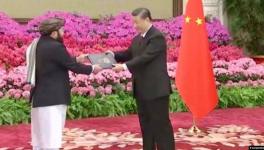COVID-19: Unlikely Virus Leaked from China Lab, Says WHO
Image Source: Firstpost
The novel coronavirus most likely first appeared in humans after jumping from an animal, a team of international and Chinese scientists looking for the origins of COVID-19 said on Tuesday, dismissing the alternate theory that the virus leaked from a Chinese lab as unlikely.
A closely-watched visit by World Health Organisation experts to Wuhan – the Chinese city where the first COVID-19 cases were discovered – did not dramatically change the current understanding of the early days of the pandemic, said Peter Ben Embarek, the leader of the WHO mission.
But it did “add details to that story,” he said at a news conference as the group wrapped up a nearly four-week visit to the city.
The visit resulted in the joint Chinese-WHO ruling out one theory on the origins of the virus. The Wuhan Institute of Virology has collected many virus samples, leading to allegations that it may have been the source of the original outbreak, whether on purpose or accidentally.
However, experts now consider the possibility of such a leak so improbable that it would not be suggested as an avenue of future study, said Embarek, a WHO food safety and animal diseases expert.
China had already strongly rejected the possibility and has laid out other theories. The Chinese and foreign experts considered several ideas for how the disease first ended up in humans, leading to a pandemic that has now killed more than 2.3 million people worldwide.
Embarek said the initial findings suggest the most likely pathway the virus followed was from a bat to another animal and then to humans, adding that the claim would require further research.
“The findings suggest that the laboratory incidents hypothesis is extremely unlikely to explain the introduction of the virus to the human population,” he said.
The WHO mission was intended as an initial step in the process of understanding the origins of the virus. Scientists have posited that it may have passed to humans through a wild animal, such as a pangolin or bamboo rat. Transmission directly from bats to humans or through the trade in frozen food products are also possibilities, Embarek said.
The WHO team's visit is politically sensitive for Beijing, which is concerned about being blamed alleged missteps in its early response to the outbreak.
The team – which includes experts from 10 countries – arrived on January 14 and visited the Huanan Seafood Market, the site of an early cluster of cases in late 2019.
Marion Koopmans, a Dutch virologist on the team, said that some animals at the market were susceptible or suspected to be susceptible to the virus, including rabbits and bamboo rats. Some could also be traced to farms or traders in regions that are home to the bats that carry the closest related virus to the one that causes COVID-19.
She said the next step would be to look more closely at farms.
Liang Wannian, the head of the Chinese side of the team, said the virus also appeared to have been spreading in other parts of the city than the market, so it remained possible that the virus originated elsewhere.
The team found no evidence that the disease was spreading widely any earlier than the initial outbreak in the second half of December 2019.
“We haven't been able to fully do the research, but there is no indication there were clusters before what we saw happen in the later part of December in Wuhan,” Liang said.
Dr. Peter Daszak, another member of the team, mentioned that the point of focus regarding the origins of the virus may shift to South-East Asia. “We've done a lot of work in China and if you map that back it starts to point towards the border and we know that there is very little surveillance on the other side in the whole region of South-East Asia,” the BBC quoted him saying.
According to Daszak, there was a web supply chains to Huanan market which could be traced back to other countries. He reportedly said the supply chains would now be an area of interest.
Daszak had told The Associated Press late last week that they enjoyed a greater level of openness than they had anticipated, and that they were granted full access to all sites and personnel they requested.
While China has weathered some localised resurgences of infection since getting the outbreak under control last year, life in Wuhan itself has largely returned to normal.
With AP/PTI inputs
Get the latest reports & analysis with people's perspective on Protests, movements & deep analytical videos, discussions of the current affairs in your Telegram app. Subscribe to NewsClick's Telegram channel & get Real-Time updates on stories, as they get published on our website.
























